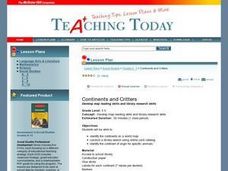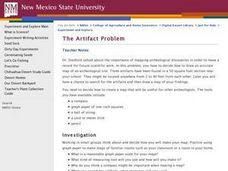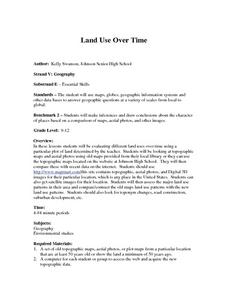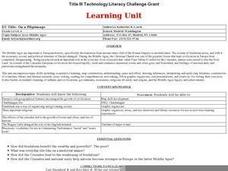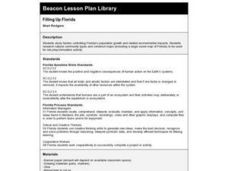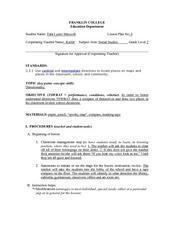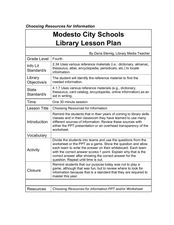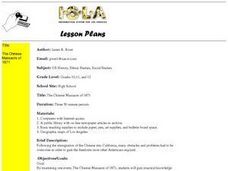Curated OER
Oceans: A Sensory Haiku
Young scholars create an ocean haiku. In this haiku lesson plan, students use their five senses to write a haiku. Young scholars watch videos about the ocean, make a sensory portrait, and create a class haiku.
Curated OER
Medial Consonants, Hard and Soft c and g
Students participate in a series of lessons that are used to develop phonics skills. There are a variety of activities and a curricular map is included in the plan. A good list of age appropriate texts is given for extensions of going to...
Curated OER
North, South, East, and West
A basic lesson on the teaching of the cardinal directions awaits your class. They are directed to go to different parts of the playground and where they attempt to describe their location in relation to each other by using the cardinal...
Curated OER
Revolutionary Boston
Students annotate core maps to explain either the political or the military situation in the British North American colonies, using Boston as a case study. They explain the British military strategy for suppressing the rebellion in Boston.
Curated OER
Continents and Critters
Students investigate and identify the continents of the world. They identify and locate the seven continents on a map, and label a coloring page of a world map. Students then conduct research on an assigned continent, and write and...
Curated OER
Famous Afro-Americans Historical Sites Recognized by the National Park System
Students use the library to find historical information about each Afro-American. They use magazines, articles from newspapers, and oral histories from video tapes and slide presentations to write biographical sketches about each...
Curated OER
A Place Called Nepal
Students investigate maps of Nepal and then create their own to disover how human activity is influenced by terrain and climate. Students participate in a trek across Nepal simulation to imagine the challenges people have to face...
Curated OER
The Artifact Problem
Students work in small groups and make a map of a familiar room. In this artifact lesson plan, students decide on a suitable scale for their maps, the tools they will use and how they will make it and decide on strategies they would use...
Curated OER
Land Use Over Time
High schoolers view aerial photos and topographic maps of their local area. They compare and contrast major land use patterns over time by comparing these images to maps that are at least 50 years old. They analyze them using the four...
Curated OER
Canada Geography PowerPoint
Students create a PowerPoint about Canadian geography or history. In this Canada lesson, students spend two days researching their Canadian topic in the library and online. They create a PowerPoint presentation and add pictures taken...
Curated OER
On a Pilgrimage
Sixth graders engage in a variety of learning experiences surrounding the study of the Middle Ages. They construct a map of Europe, create a graphic organizer for the hierarchy of feudalism, design their own family crest, and write their...
Curated OER
Joseph Had a Little Overcoat Lesson Plan
Learners discuss various features of a book, aspects of the story, and then engage in a retelling of the story. In this early childhood lesson plan, students identify the author, illustrator, and title of a book, Joseph Had a Little...
Curated OER
Filling Up Florida
Students study factors controlling Florida's population growth and related environmental impacts. They research natural community types and construct maps (including a large-sized map of Florida) to be used for a simulation activity.
Curated OER
The Pirates of the Caribbean
Third graders participate in a demonstration lesson that shows a map of the Caribbean Islands. They examine a natural resource that each island is known for. Next, they listen to a read aloud of Gail Gibbons, "Pirates: Robbers of the...
Curated OER
Basin & Range Faulting
Students identify that the crust of the earth is constantly moving and that with the exception of faults accompanied by earthquakes, this rate of movement is far too slow to notice. Then they print a copy of cross-section map A and...
Curated OER
Directionality
Second graders discuss the cardinal directions and intermediate directions and then look at the spooky map to locate different points on the map. They answer questions about where things are located in reference to another object and...
Curated OER
Geography of the Roman Empire
Students explore the Roman Empire. In this ancient Rome lesson, students research regions of the Roman Empire and present their finding to their classmates. Students also use an interactive map to practice placement of the regions within...
Curated OER
Growing Coral
Students define the words coral and coral reef, and identify the Great Barrier Reef on a map or a globe. They observe crystal formations that develop in a way similar to the way coral polyps create their calcium carbonate cups.
Curated OER
We Are One World
Students examine discrimination, prejudice, and bias in the world. In this tolerance lesson, students research examples of prejudice in different countries. They then identify the Core Democratic Values in song lyrics. Students locate on...
Curated OER
Cultural Ties in Your Nebraska Community
Tenth graders use different resources to collect data about how their specific community is affected by international ties and relations. Resources include local library, city hall, travel agent, visitors bureau, and Chamber of...
Curated OER
Which reference book helps most?
Fourth graders utilize various reference materials to find specific types of information. In this library research lesson, 4th graders choose the best source of information from the library's reference collection to answer questions.
Curated OER
What On Earth
Students explore earth science through concept mapping, discussion, and self-discovery.
Curated OER
The Chinese Massacre of 1871
Students investigate the historical Chinese Massacre of 1871. They conduct Internet research, analyze period maps of Los Angeles, read an article, design a timeline, and write a research paper.
Curated OER
Breaking Through Reading Roadblocks!
Students apply reading strategies to interpret a map, a diagram, a scientific chart, and a historical text. In small groups, they examine and analyze various documents. They present their findings to the class.




